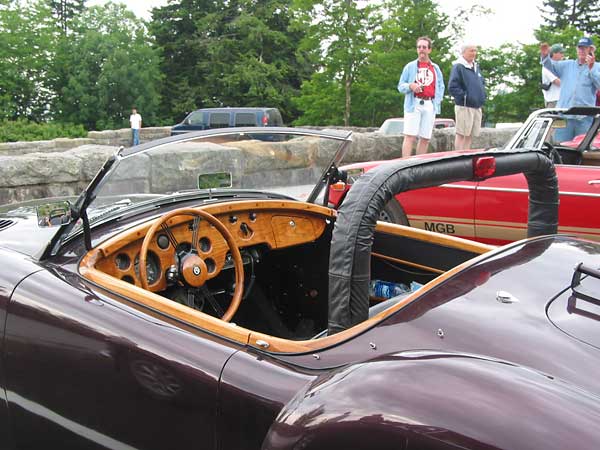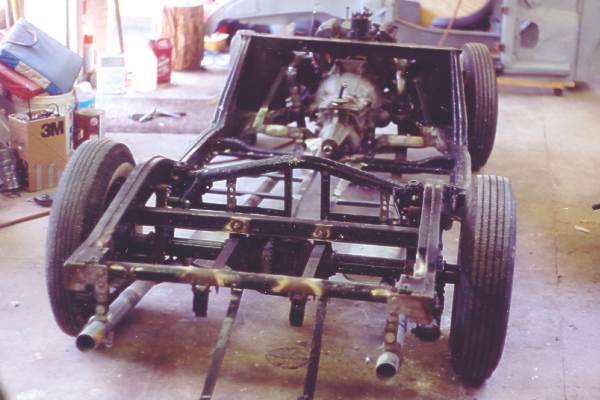
Jim Wiebe's 1959 MGA with a Chevy 3.4L V6
as published in British V8 Newsletter, Volume XIV Issue 2, August 2006(note: this car also appeared in Volume XI Issue 1 as originally assembled with a 2.8L engine. See below.)
Owner: Jim Wiebe
City: Madison, CT
Model: 1959 MGA
Engine: GM Sixty Degree V6 (3.4L Crate Motor)
Conversion performed by: Owner
| Intake: | GM / Rochester Varajet, stock cam. |
| Engine Electrical: | MSD ignition / Accel coil / Bosch Alternator. |
| Cooling: | Mustang V8 Radiator. |
| Exhaust: | custom fabricated, with Cherry Bomb Turbo mufflers. |
| Transmission: | Borg Warner T5 5-speed. (MG master cylinder actuates GM slave cylinder...) |
| Suspension: | MGB Front and rear, with MGB 3.909:1 rear axle. Stock MGB brakes. |
| Wheels/Tires: | stock MGA steel disc wheels with Dunlop tires. |
| Interior: | GM S10 gauges have been integrated into a custom wooden dashboard. Wooden
trim (in solid walnut) continues around doors and rear deck lip. Custom
made matching walnut steering wheel. The windshield has been angled back
approximately twelve degrees from stock. |
| Other modifications: | The front crossmember was notched to accomodate the engine, and the fuel
tank was centered to accomodate symmetrical dual exhaust. |
| Weight: | 2000lb |
| Completed: | Probably never! |
| Miles Driven: | 25,000 (as of the British V8 2006 meet). |








| Engine: | A box stock, 2.8L, 60 degree Chevy V6 from a 1987 Chevrolet S-10. Bore/stroke = 3.5/2.99,
cam is a GM14024278, with a lobe separation angle of 107 degrees. Intake/exhaust valves are 1.72/1.42
(engine was the "throttle body" type, so it has the larger valves). Engine mounts are standard MGA,
with new plates bolted to the engine block. The sump was shortened 2", but a section from a Volvo was
added, increasing the capacity to about 4 1/2 quarts. A single Rochester 2SE on a stock GM manifold,
with the EGR valve blocked. Throttle linkage is modified GM. The stock air cleaner was sectioned to
drop down around the carburetor, with two 4" flex air tubes to draw cool air from the front of the
radiator. The carb sits on a wedge shaped spacer block to level it and to isolate it from engine heat.. |
| Transmission: | Borg-Warner T- 5, 3.97/2.34/1.46/1.00/0.79 gear ratios. The shift lever was shortened and reshaped to
fit. The clutch, T/O bearing, flywheel, and bell housing are all stock GM from the same donor vehicle
as the engine. A 5/16" compression fitting mated the stock MGA M/C to the GM S/C. The drive shaft was
modified to mate the GM yoke to an MG sized U-joint. The transmission mount lands on an existing
crossmember. |
| Cooling: | The Radiator is an 18x19, 3-row, copper unit, made by Modine for a 1965 289 Mustang, and fits between
the frame rails. An electric fan from a 1983 Oldsmobile, in a puller configuration, provides ample
cooling, even on 95 degree days. The fan comes on only after extended idling. |
| Exhaust: | Custom fabricated log manifold, with 1 3/8" primary tubes, feeding low restriction "cherry bomb"
mufflers, through 2" exhaust pipes. No gaskets were used. |
| Rear axle: | Stock 1967 Salisbury, 3.9:1. A fabricated emergency cable bracket uses a stock MGA cable. An
MGC rear axle is on hand as a possible future replacement. |
| Frame/body: | The frame was boxed, and the front cross member was reshaped to clear the crank pulley. New
hangers were made to re-hang the gas tank in the center, and to hang the exhaust pipes.
New panels of 16 gage steel were placed in the floor areas. |
| Suspension: | Stock front except MGB-V8 bushings. Stock 1967 MGB rear. |
| Brakes: | Stock MGA drums in front, stock MGB drums in rear. Half of the conversion parts are
on hand to convert to an MGB kingpin and disc brakes in front, but the conversion is
incomplete at present. |
| Wheels/Tires: | Stock MGA wheels with 165-R-15 Dunlop tires. |
| Interior: | Stock seats and upholstery. The dash is black walnut with a rim that runs around the cockpit. The
steering wheel is reduced in diameter by about 2" and edged in black walnut.
The cowl behind the seats is cut back 7" to open the cockpit, with a walnut edge that runs around the doors to the dash. The windshield is angled back about 12 degrees, lowering it about 2". A new fabricated polycarbonate front grill and cast fiberglass hood air vents help air movement. The MGA vents in the front fenders vent cool air into the footwells. The transmission tunnel was expanded, and the pedals were bent sideways to clear, but leaving plenty of footroom. |
| Electrical: | A stock GM 35 amp Bosch alternator from the S10 donor mounts on custom brackets. Ignition is
by an MSD 6A control module, with an Accel super stock coil. The gauges are also from the S10
donor. The battery was relocated to the right side firewall. |
| Comments: | Car has covered 3,000 miles since completion. It is geared to go 131 mph at 5,500 rpm, but "I'll never do it!
65 seems like you're flying."
The 90 degree drive on the speedo cable "disassembled" itself. (The 90 degree drive was required to clear the tunnel, along with a ratio adapter to make the speedometer read correctly.) The tach still reads 33 percent high. Sketch out a plan, set no time limits, and, like the Nike ad says - just do it! Leave the sandblasting to a commercial shop - it's so damn boring! Look for a 3.4 crate engine and perhaps a late Camaro 5-speed (V8 model). I'm told you wouldn't have to widen the tunnel or bend the pedals for clearance with that combo. Also, the shifter would be in the "correct" position, although I've gotten used to the odd shift pattern caused by the forward position. This car was made from 4 "basket case" wrecks. I would not have done it to a perfect "numbers matching" car, but now that it's done, it's great fun to drive and I'm glad I did it. |

